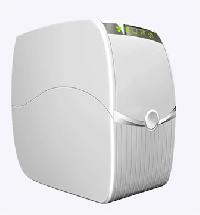
table top ro system
We Offer table top ro system. Model Hf 8 input Power 220 Volt 50 Hz. purifying Capacity 8-10l water Tank 8 Ltr duty Cycle 110 Ltrs Day Max booster Pump 24 V, Dc (1no) ro Membrane .0001, 5075 Gpd max Feed Water Tds 1500ppm max Feed Water Hardness 400 Ppm suitable for Table Top
...more
domestic ro
Model HF/ 008/ 08 Input Power 20volt Ac Purifying Capacity 8-10 Ltrs/Hr (depending upon the quality of raw water) Duty Cycle 110 Ltrs / day (max) Booster Pump 24 volt Dc. Filter Cartridge Sediment 0.5 micron, Granule Activated Carbon R O Membrane 0.0001 micron 50/75 G.P.D ( 1 no. ) Max Feed Water Hardness 400 ppm Max Feed Water TDS 1500 ppm Suitable for Table top
...more
Commercial Ro System
We Offer commercial ro system. Water to be purified is forced out of several layers of semi-permeable membrane by applying external pressure. This process ensures that the very pure water is made available at the end of process by removing every dissolved impurities like salts heavy metals and chemical contaminants besides removing bacteria, viruses and foreign particles. This process is accepted and used worldwide for making the PURE WATER. It is well known fact that our body is having 70% of WATER. The less intake of water causes death and contaminated water is a slow poison for the body. The different chemicals present in the Water is causing alarming problems in the human bodies such as Arsenic causes skin damage, circulatory system problem and risk of cancer, Fluoride causes bone diseases and mottled teeth in children Barium causes High blood pressure, Cyanide causes Thyroid problem, Cadmium causes Kidney failure, Mercury causes kidney damage, Nitrate causes Blue baby syndrome, Copper causes gastrointestinal an
...more
Commercial & Domestic Revers osmosis system
“Advance Water Solutions” is upcoming company in the field of WATER TREATMENT with ISO:9001:2008 and UPSIDC-registration In our field we assure our esteemed customers our Services and Technical Support by our qualified engineers and best products through our well equipped and advance factory at LUCKNOW. A TOUCH OF CARE A leader in Indian water industry, Advance strives to make its customers adaptive enterprises in the long run to enable them to meet business challenges through capitalizing on opportunities for leveraging business growth. For Advance, a product sold is not the end but the beginning of an ongoing relationship. Armed with a sharp focus duly translated through product innovation, a result of constant customer feedback, Advance lives up to its promise day-in and day-out. Even a small problem is given up to its promise day-in and day-out. Even a small problem is given utmost attention as it treats its customers as partners to progress, that is portrayed through and increasing customer base, a clear reflection to its deep sense of commitment and attitude. What is Sewage Treatment Plant ? t Sewage Treatment Plant is a facility designed to receive the waste from domestic, commercial and industrial sources and to remove materials that damage water quality and compromise public health and safety when discharged into water receiving systems. Objective: - The Principal objective of waste water treatment is generally to allow human and industrial effluents to be disposed of without danger to human health or unacceptable damage to the natural environment. ?Conventional wastewater treatment processes ?Conventional wastewater treatment consists of a combination of Physical, chemical, and biological processes and operations to remove solids, organic matter and, sometimes, nutrients from wastewater. Preliminary treatment The objective of preliminary treatment is the removal of coarse solids and other large materials often found in raw wastewater. Removal of these materials is necessary to enhance the operation and maintenance of subsequent treatment units. Preminary treatment?? operations typically include coarse screening, grit removal and, in some cases, communication of large objects. A. Primary treatment The objective of primary treatment is the removal of settleable organic and inorganic solids by sedimentation, and the removal of materials that will float (scum) by skimming.? B. Secondary treatment The objective of secondary treatment is the further treatment of the effluent from primary treatment to remove the residual organics and suspended solids. In most cases, secondary treatment follows primary treatment and involves the removal of biodegradable dissolved and colloidal organic matter using aerobic biological treatment processes. Aerobic biological treatment is performed in the presence of oxygen by aerobic microorganisms (principally bacteria) that metabolize the organic matter in the waste water, thereby producing more microorganisms and inorganic end-products (principally CO2, NH3, and H2 O). Several aerobic biological processes are used for secondary treatment differing primarily in the manner in which oxygen is supplied to the microorganisms and in the rate at which organisms metabolize the organic matter. Common high-rate processes include the activated sludge processes, trickling filters or bio filters, oxidation ditches, and rotating biological contractors (RBC). A combination of two of these processes in series (e.g. bio filter followed by activated sludge) is sometimes used to treat municipal wastewater containing a high concentration of organic material from industrial sources. Swimming Pool Pollution in pool water comes either from the environment or is carried into the water by the swimmers. Environmental pollution includes dust, leaves, chemical wastes, pollen, spores, bacteria and so on, that are blown into the water by the wind. Swimmers carry other pollutants into the water: sweat, suntan oils, urine, bacteria, viruses, etc. Every swimming pool has a circulation pump and filter. The filters most common these days are sand filters, and are much easier to maintain than the earlier diatomaceous filters of a few years back. The pool pump ensures that the swimming pool water moves through the filter every day, thus removing unwanted pollutants and disinfected organic materials as quickly as possible. Other common pool filters include DE (diatomaceous earth) filters, which are able to filter out finer particles of dirt, though they require more maintenance. Cartridge filters are also quite widespread and are quite simple to maintain. Nowadays a filter sand substitute containing zeolite is gaining in popularity. The zeolite (specifically the clinoptilolite mineral) is able to filter particles as finely as DE filters in addition to having a capacity to absorb ammonia and its complexes (reducing combined chlorine and offensive chlorine odours), while not requiring any extra maintenance. Generally, the swimming pool pump should run for at least 6 - 8 hours each day. There is usually a timer which cycles the pool pump on and off to ensure this constant filtration. The circulation of pool water will remove floating or suspended particles of dirt from the water, but has no effect on the substances which have settled to the bottom of the swimming pool or "stuck" to the walls. Depending on the environmental conditions and swimmer load, the swimming pool needs regular brushing and vacuuming, generally about once a week in the swimming season for home pools. With the circulation pump turned off, the walls and floor of the pool are swept with a stiff brush. When the "dust" from the brushing settles, it is vacuumed off the floor of the swimming pool. The pool must also be vacuumed after treating with a flocculant. Nowadays, there is a variety of automatic swimming pool cleaners, which suck the dirt off the walls and floor of the swimming pool whenever the pool pump is running. These are really great for pool owners who never seem to have the time for swimming pool chores. Now that the vacuuming is done, it is time to backwash the filter. Sand filters trap dust and dirt, as the name implies, in a bed of sand. When the filter has accumulated a large amount of dirt, the water cannot pass freely through the sand and the filter loses efficiency as the pressure increases. Backwashing sends water backwards through the filter and flushes the trapped dirt out. After backwashing, you will notice an increase in return pressure to the pool, and if you have a pressure guage, you should notice an increase of at least 0,5 bar. With the pool pump off, turn the filter setting to "backwash". Remove the leaf basket from the weir, clean and replace it. Turn on the pump and let it run until the water coming out of the waste pipe is clear. This generally needs a few minutes. Turn off the pump and set the filter to rinse; this cleans out the pipes and prevents any dirt from returning to the pool. It also settles the sand in the filter which has been stirred up by the backwashing. Run the pump for about a minute and then turn it off. Set the filter to "closed". Open the leaf trap near the pump, remove the basket and clean out all the leaves, twigs and rubbish it may have collected. Replace the basket, set the filter to "filter" and turn your pump back to its automatic (timer) operating position. Great! The swimming pool looks clean and the filter has been rejuvenated. Now it's time to test the pool water and adjust the pH and chlorine levels. If your swimming pool needs topping up, now is the ideal time to put the hose in the pool. It is very healthy for the swimming pool water to be replaced bit by bit, to prevent it becoming stale and creating chemical problems or pool water problems. A routine of 5-minute backwashing followed by a 1-minute rinse every week will ensure that you replace about 5% of the swimming pool water each month. This means a complete changeover of swimming pool water approximately every 2 years. REMEMBER too, that the useful lifespan of the sand in your filter is 3-5 years. If you neglect to change the sand, your filter will not be able to remove the finer particles of dirt and your swimming pool can never be completely clean. Have the pool filter opened for inspection at least every 2 years to avoid filtration problems. ________________________________________
...moreBe first to Rate
Rate ThisOpening Hours